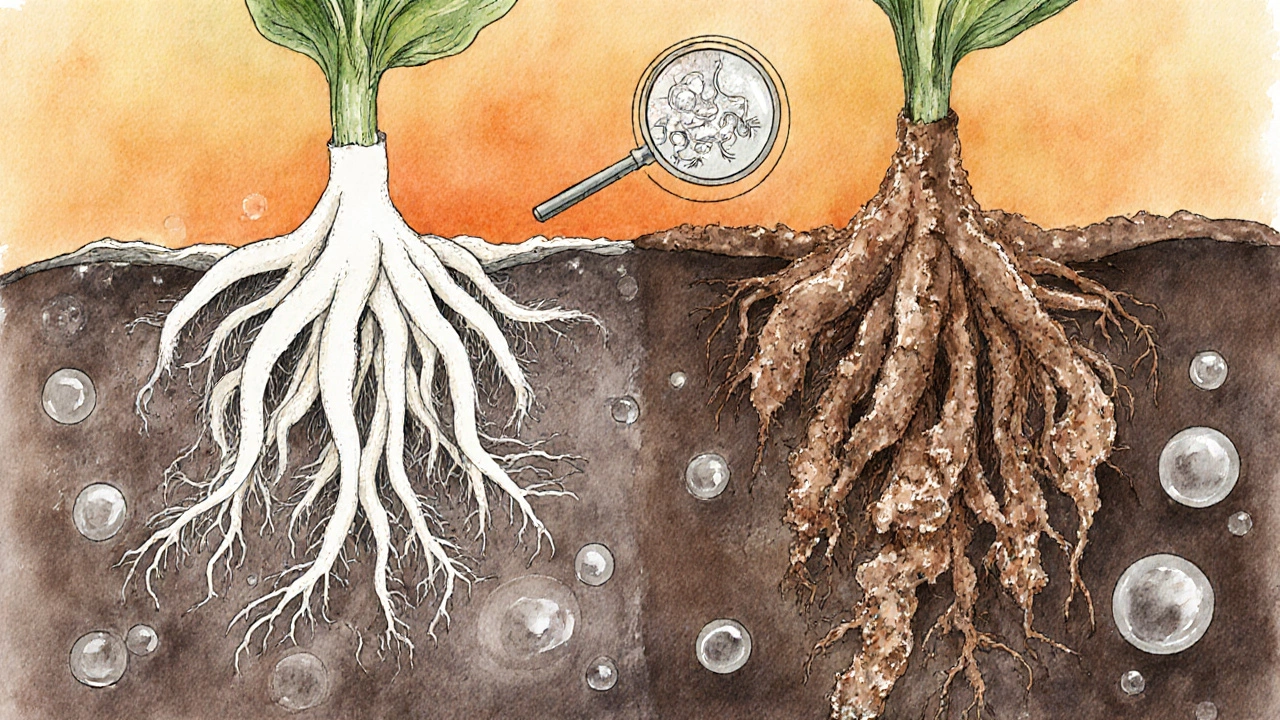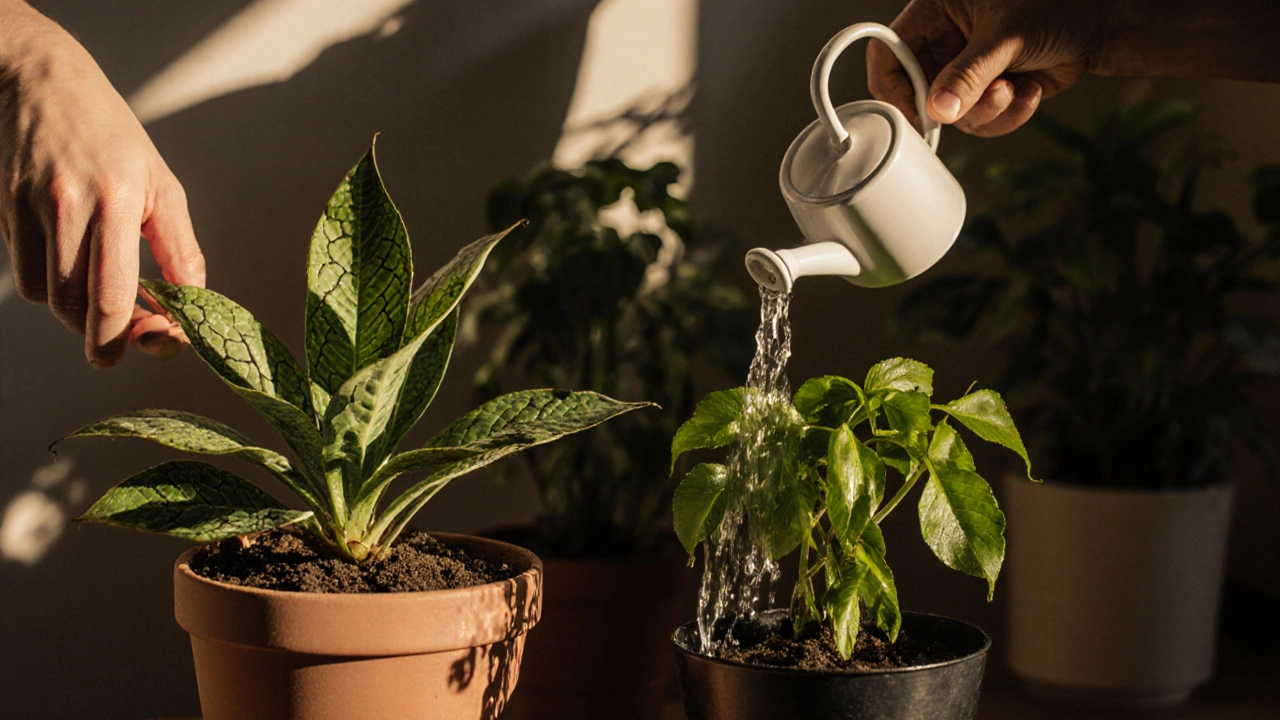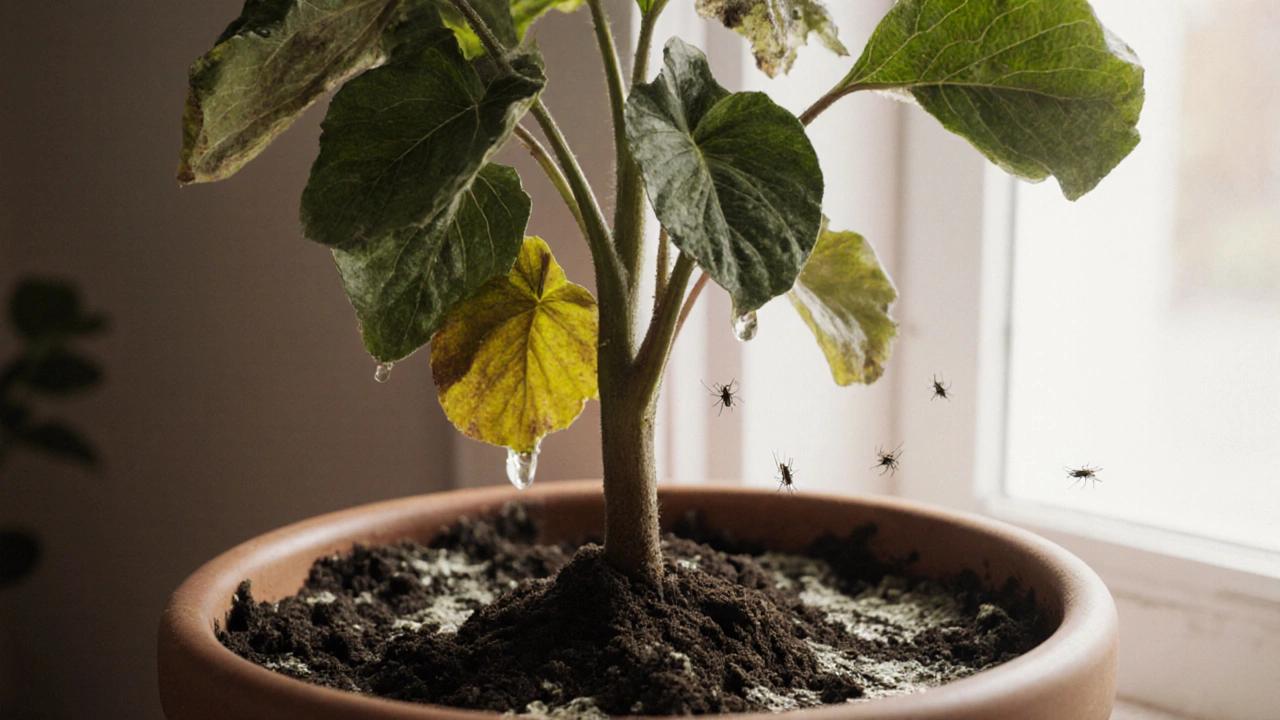Plant Watering Diagnosis Tool
This tool helps you determine if your plant is overwatered or underwatered based on key symptoms described in the article.
1. Check the soil moisture
2. Observe leaf color and texture
3. Review root condition if possible
4. Select options below to get your diagnosis
Your plant is being diagnosed...
Check soil moisture first for best results
Most people kill their indoor plants not because they forget to water them, but because they water them too much. It’s the opposite of what you’d expect. You think, "If I water it more, it’ll thrive," but instead, the leaves turn yellow, the stem gets soft, and the plant just… gives up. Overwatering is the silent killer of houseplants. And yet, underwatering gets all the blame. So which is worse? The answer isn’t simple-but if you had to pick one, overwatering is the bigger threat.
Why overwatering is the real problem
Plants don’t drink water like you drink coffee. They take in moisture through their roots to pull nutrients from the soil and move them up through their stems. But their roots need air too. When the soil stays soggy for more than a day or two, the tiny root hairs that do the absorbing start to suffocate. Without oxygen, they die. And once those roots rot, the plant can’t take up water or food-even if you stop watering it.
Root rot doesn’t show up right away. You might water your fiddle leaf fig every Monday like clockwork, and it looks fine for weeks. Then one day, the lower leaves drop. The stem feels mushy. You panic, add more water, and the plant collapses in days. That’s not dehydration. That’s a system-wide failure. A 2023 study from the Royal Horticultural Society found that over 70% of indoor plant deaths in UK homes were linked to consistently wet soil, not dry soil.
Overwatering also invites fungus gnats, mold on the soil surface, and fungal diseases like Pythium and Phytophthora. These don’t just hurt the plant-they spread to other pots nearby. One overwatered snake plant can turn your whole windowsill into a death zone.
Underwatering is easier to fix
Underwatering? It’s painful to watch. The leaves curl, crisp at the edges, and droop like they’ve given up. But here’s the good news: most plants bounce back fast if you catch it early. Even a desert succulent that’s been dry for three weeks will perk up within 24 hours after a good soak.
Why? Because plants have built-in survival tricks. When they sense drought, they slow down growth, shut down stomata (tiny pores on leaves), and pull water from older leaves to save the new ones. They’re designed to endure dry spells. A ZZ plant, a pothos, or a snake plant can go weeks without water and still survive. They don’t like it, but they’ll live.
And unlike root rot, underwatering doesn’t leave lasting damage unless it’s extreme. If you miss a few weeks and the soil is bone-dry and pulling away from the pot edges, just give it a slow, deep soak. Place the pot in a sink or bucket of water for 20 minutes. Let it drain. Watch the leaves firm up over the next day. That’s recovery. No fungicide needed. No repotting. Just water.
How to tell the difference
You can’t guess. You can’t rely on the calendar. You can’t judge by how the plant looks alone. You need to check the soil. Here’s how:
- Stick your finger in up to the second knuckle. If it’s damp, wait.
- If it’s dry all the way down, it’s time to water.
- For bigger pots, use a wooden skewer. Push it in. Pull it out. If it comes out clean, the soil is dry. If it’s muddy, wait.
- Weight matters. Lift the pot. If it feels light, it’s dry. If it feels heavy, it’s still wet.
Don’t trust apps or moisture meters. Most cheap ones are inaccurate. And don’t assume all plants need the same thing. A peace lily likes moist soil. A cactus needs bone-dry soil between waterings. Your watering schedule should change with the plant, the season, and the light.

Seasonal changes affect watering
In winter, most indoor plants slow down. Growth stops. They don’t need as much water. But people keep watering like it’s June. That’s when overwatering spikes. Your monstera isn’t thirsty just because it’s November. It’s resting. Watering every week in winter is like giving someone coffee every hour while they’re napping.
In spring and summer, when light increases and temperatures rise, plants start growing again. That’s when they need more water. But even then, don’t rush. Let the top 2-3 inches dry out before watering again. That’s the rule for 80% of common houseplants.
Signs of overwatering vs. underwatering
Here’s a quick guide to spot the difference:
| Sign | Overwatering | Underwatering |
|---|---|---|
| Leaf color | Yellow, often starting with older leaves | Brown, crispy edges, usually on newer leaves |
| Leaf texture | Soft, limp, sometimes translucent | Brittle, dry, curled |
| Soil condition | Always wet, smells sour, mold on top | Dry, cracked, pulls away from pot |
| Roots | Brown, mushy, smells rotten | White or light brown, firm, may be shriveled |
| Recovery time | Days to weeks, if any | Hours to days after watering |

What to do if your plant is overwatered
If you catch it early-before the stem turns mushy-you might still save it.
- Stop watering immediately.
- Move the plant to a brighter spot (but not direct sun). More light helps soil dry faster.
- Check the pot. Does it have drainage holes? If not, repot it into one that does.
- Gently remove the plant. Shake off the soil. Cut off any black, slimy roots with clean scissors.
- Repot in fresh, well-draining soil. Use a mix with perlite or orchid bark.
- Wait a full week before watering again. Then water lightly.
If the stem is already soft or black, the plant is likely gone. Don’t waste time. Take a cutting from a healthy part if you can, and start over.
How to avoid both problems
The best way to fix watering is to stop guessing. Here’s what works:
- Use pots with drainage holes. Always. No exceptions.
- Don’t let pots sit in saucers full of water. Empty them 15 minutes after watering.
- Water deeply, then let it dry. A little splash every few days is worse than no water at all.
- Group plants by water needs. Don’t put a cactus next to a fern.
- Write down when you water. Even just a note on your phone. You’ll see patterns.
- Learn your plants. A spider plant can handle neglect. A calathea can’t.
Most people think they’re being loving by watering often. But plants don’t need love-they need balance. They need the right amount of water, at the right time, in the right soil. Overwatering isn’t care. It’s control. And plants don’t respond to control. They respond to rhythm.
Final verdict: Overwatering is worse
Underwatering is stressful, but it’s usually fixable. Overwatering is a slow, invisible collapse. It damages roots, invites pests, and often kills before you even realize something’s wrong. You can recover from a dry spell. You can’t recover from rot.
So if you’re unsure-wait. Let the soil dry. Check it twice. If you’re still not sure, wait another day. Your plant will thank you. And honestly? It’s better to be a little late than too early.
Can a plant recover from overwatering?
Yes, but only if the roots haven’t fully rotted. If the stem is still firm and the leaves are just yellowing, stop watering, improve drainage, and let the soil dry out. Cut away any mushy roots and repot in fresh, airy soil. Recovery takes weeks, not days. If the stem is soft or black, the plant is likely beyond saving.
How often should I water my indoor plants?
There’s no fixed schedule. Most indoor plants need watering every 1-3 weeks, depending on the species, pot size, light, and season. Always check the soil first-stick your finger in up to the second knuckle. If it’s dry, water. If it’s damp, wait. In winter, most plants need water half as often as in summer.
Do drainage holes really matter?
Yes. Without drainage holes, water pools at the bottom and stays there. Even if you water lightly, the soil stays saturated. That’s how root rot starts. If your favorite pot doesn’t have holes, use it as a decorative outer pot and keep the plant in a plastic nursery pot with holes inside.
Why do my plant’s leaves turn yellow after I water them?
Yellowing after watering is a classic sign of overwatering. The roots are suffocating and can’t absorb nutrients properly. The plant pulls nitrogen from older leaves to survive, turning them yellow. Stop watering, check the soil moisture, and improve airflow. Don’t fertilize-it’ll make things worse.
Is tap water safe for indoor plants?
In most cases, yes. Tap water in the UK is generally fine for houseplants. If your water is very hard (leaves white residue on soil), let it sit out overnight to let chlorine evaporate. Rainwater or filtered water is ideal, but not necessary. Don’t use softened water-it has salt that builds up and harms roots.
